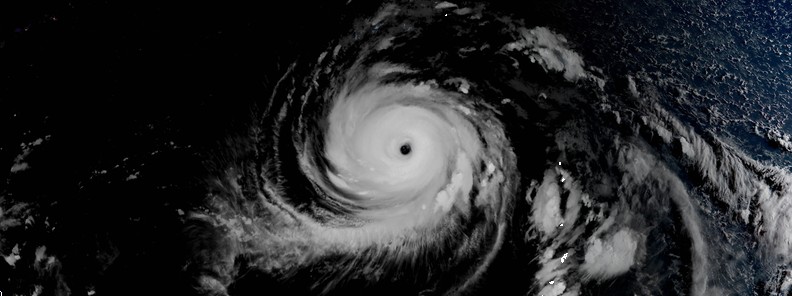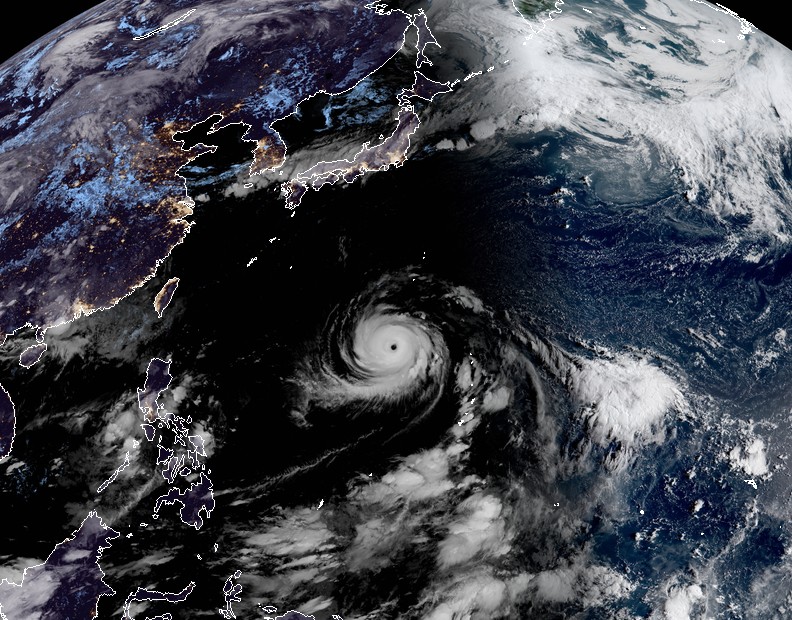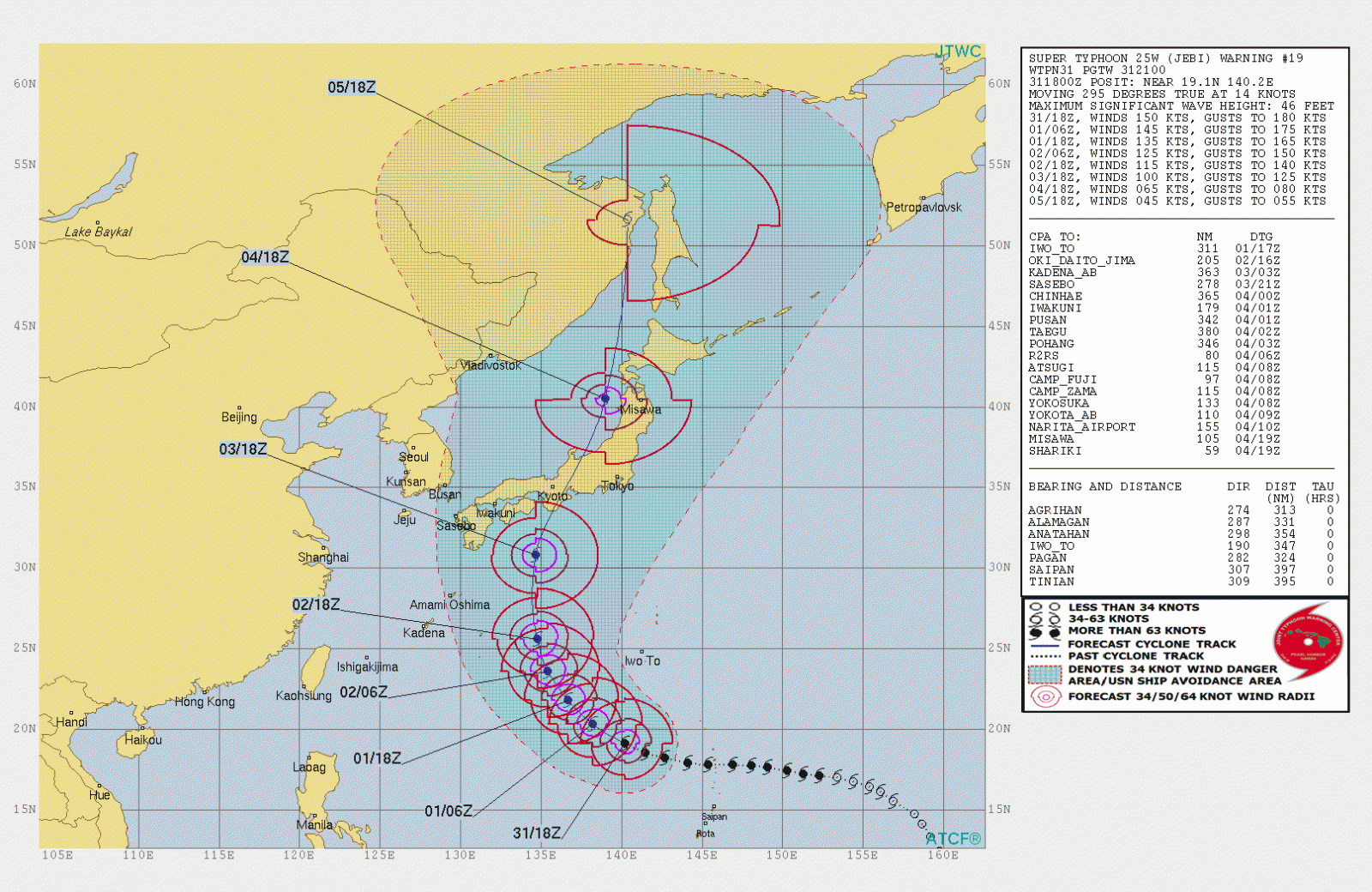Super Typhoon “Jebi” ties for strongest storm on the planet in 2018, heading toward Japan

Tropical Cyclone "Jebi" reached Super Typhoon strength on August 31, 2018, and tied with Jelawat and Maria for the strongest storm on the planet in 2018. The current forecast track takes Jebi over Japan's Honshu island on September 3. The main threat from this storm will be rainfall. Authorities are warning residents to prepare for flooding and landslides.
At 18:00 UTC on August 31, the center of Super Typhoon "Jebi" was located approximately 640 km (400 miles) south of Iwo To, Japan and was moving WNW at 26 km/h (16 mph) over the past 6 hours, according to the JTWC. Its maximum sustained winds were 278 km/h (150 mph) and gusts to 333 km/h (180 mph).
Animated enhanced infrared satellite imagery shows the system has retained a 41 km (25 mph) sharply outlined eye, albeit larger, after a recent eyewall replacement cycle. Feeder bands also remain tightly wound into the eye, making Jebi a compact and very symmetric cyclone.

Super Typhoon "Jebi" at 20:30 UTC on August 31, 2018. Credit: JMA/Himawari-8, RAMMB/CIRA
JTWC's environmental analysis indicates the cyclone is in an area with low vertical wind shear, robust radial outflow enhanced by a TUTT cell to the northwest, and warm sea surface temperatures (29 – 31 °C / 84.2 – 87.8 °F).
Diminishing outflow, as the TUTT cell moves further away, will cause gradual weakening over the next 72 hours and Jebi's maximum sustained winds are expected to drop to 185 km/h (115 mph).
The system will accelerate northward to north-northeastward toward central Honshu after 18:00 UTC on September 3, exit into the Sea of Japan and be over eastern Russia near Sakhalin Island by 18:00 UTC on September 4.
Jebi is expected to weaken more rapidly during this phase as it encounters increasing vertical wind shear, land interaction and cool sea surface temperatures. Concurrently, it will begin extratropical transition by 18:00 UTC, September 4 and become a gale-force cold-core low with and expansive wind field by 18:00 UTC, September 5.

Jebi is the 21st named storm of the 2018 Pacific typhoon season. With maximum sustained winds of 278 km/h (150 mph) and central pressure of 915 hPa on August 31, it tied with Jelawat and Maria for the strongest storm on the planet in 2018.
Featured image credit; Super Typhoon "Jebi" at 20:30 UTC on August 31, 2018. Credit: JMA/Himawari-8, RAMMB/CIRA

Виктор Родин,
The idea would work great in a fairy tale world where people weren’t driven by Greed and Fear. As it stands today, nobody cares enough to drop what they are doing and invest millions into any of these projects. Also, being ecologist, you should know that biosphere doesn’t work that way. It would take hundreds of years to reverse the damage by planting trees. We only got about 3-4 years before the entire global population starts running in panic as the extremes increase exponentially. These are baby storms compared to what’s in store for us. At this point, the entire world would need to drop everything and start fixing the problem. Too bad it doesn’t work this way. But good luck 🙂
Thank you Виктор Родин. our world needs you and many more like you. I love you for what you’re doing.
Super Typhoon “Jabie” connects the strongest storms on the planet in 2018, heading to Japan.
Japan’s rescue from all kinds of cataclysms – including other countries – is in Africa. Of the many programs that include natural technology, I’ll give one – “African”.
I am an active ecologist. For today, my programs eliminate all kinds of destructive natural disasters. However, in 2019 irreversible cataclysms will appear – and therefore local and global work to eliminate the effects of warming should begin immediately.
Africa. Throughout the length of the Niger River, I produce 4-5 cubic kilometers of fresh water. In the empty territories of the Republic of Mali – you can continue to the republics of Niger, Chad, Sudan, and so on – I form loop channels. On both sides of the canals, I plant 10 billion tree seedlings. Results:
First. The seedlings of trees will cover the earth from the sun’s rays. Prior to planting, sections of open soil emitted air into the atmosphere at a temperature of 50 degrees Celsius. After landing – 25. The temperature of heating the African soils and heating the atmosphere decreased by half! That is, the seedlings, and then the adult trees will lower the heat waves, and they will do it without additional costs, for 250-300 years.
Second. One adult tree stores 2.5 tons of fresh water in the root system. Ten billion New forests will take 25 billion tons of water a year from the atmosphere and the ocean. That is, new plantations will eliminate typhoons and reduce the level of the World Ocean.
The third. Destroys carbon dioxide and poisonous smog in the atmosphere.
Two quotes:
Quotation: “One hectare of planted forests permanently destroys annually up to 6.5 tons of carbon dioxide and releases 5 tons of oxygen”. The seedlings will grow, and destroy carbon dioxide permanently for many hundreds of years. Nature works. Without costs, except for watering.
“One hectare of green plantations absorbs 60 tons of dust, and cleans 18 million cubic meters of air from harmful impurities.” This is the only technology in the world that destroys smog forever. Nature has been working for hundreds of years. Without additional costs, except for watering.
Sincerely, developer of environmental programs, Victor Rodin. Ukraine. Khmelnitsky NPP. Tel. Kiev Star: 961336344. Mail: dorosydos@gmail.com.
— — —
Супер тайфун «Джеби» связывает самые сильные штормы на планете в 2018 году, направляясь в Японию.
Спасение Японии от всех видов катаклизмов – в том числе других стран – находится в Африке. Из многих программ, которые включают в себе природные технологии, я дам одну – «африканскую».
Я – действующий эколог. На сегодня мои программы устраняют все виды разрушительных природных катаклизмов. Однако, в 2019 году появятся необратимые катаклизмы – и поэтому локальные и глобальные работы по устранению последствий потепления нужно начинать немедленно.
Африка. По всей длине реки Нигер я произвожу 4-5 куб километров пресной воды. На пустующих территориях республики Мали – можно продолжить по республикам Нигер, Чад, Судан, и так далее, – я образую закольцованные каналы. По обеим сторонам каналов я высаживаю 10 млрд. саженцев деревьев. Результаты:
Первый. Саженцы деревьев закроют землю от солнечных лучей. До посадки участки открытых почв выбрасывали в атмосферу воздух с температурой 50 градусов Цельсия. После посадки – 25. Температура нагрева почв Африки и нагрева атмосферы уменьшилась в два раза! То есть, саженцы, а затем и взрослые деревья понизят тепловые волны, и будут это делать без дополнительных затрат, в течение 250-300 лет.
Второй. Одно взрослое дерево запасает в корневой системе 2,5 тонны пресной воды. Десять млрд. Новые лесонасаждения будут забирать из атмосферы и океана 25 млрд. тонн воды в год. То есть, новые лесопосадки будут ликвидировать ураганы и снижать уровень Мирового океана.
Третий. Уничтожает углекислый газ и ядовитый смог в атмосфере.
Две цитаты:
Цитата: «Один гектар лесонасаждений навсегда уничтожает ежегодно до 6,5 тонн углекислого газа и выделяет 5 тонн кислорода». Саженцы будут расти, и уничтожать углекислый газ постоянно в течение многих сотен лет. Работает природа. Без затрат, кроме полива.
«Один гектар зеленых насаждений поглощает 60 тонн пыли, и очищает от вредных примесей 18, миллионов кубометров воздуха». Это и есть единственная технология в мире, которая уничтожает смог навсегда. Работает природа сотни лет. Без дополнительных затрат, кроме полива.